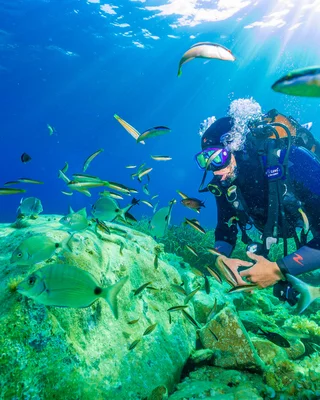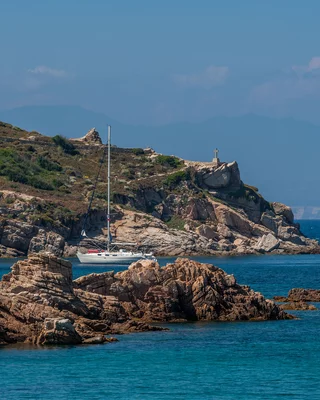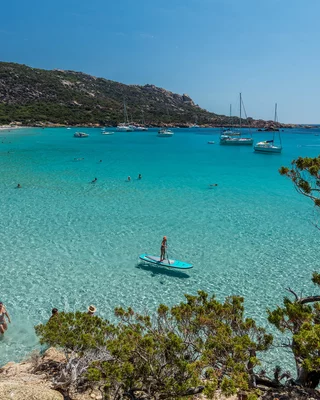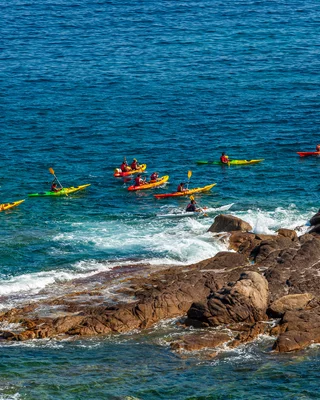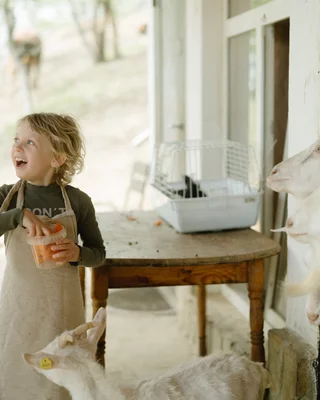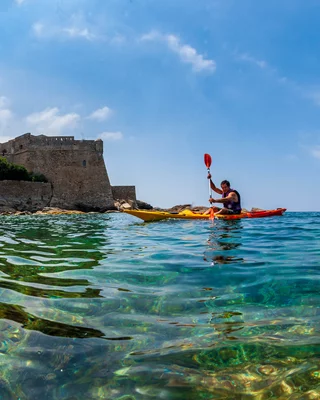Corsica's seabed
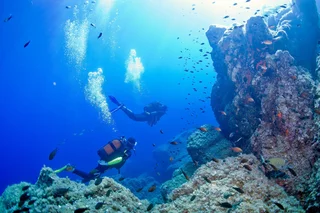
Corsica's beaches are immersed in the immense Mediterranean Sea, and its seabed is home to some of the world's strangest and most wonderful creatures. An underwater scenery you'd never suspect, made up of caves, slabs, faults and mounts, that delights the eyes of divers and fascinates researchers.
Plan your customized trip now
Head for the most beautiful diving landscapes
Although groupers, mostelles and sars abound in Corsica, there are many other treasures. In Calvi, plankton enthusiasts (plants and animals that can't swim on their own) examine it every day. STARESO(Station de Recherches Sous-Marines et Océanographiques de Calvi), a scientific base located at the tip of Revelatta, trains around a hundred marine biology students to observe the planet's largest ecosystem. This underwater rainforest is the first link in the food chain.
The seabed reveals a wild Corsica with its posidonia, a vast underwater meadow with multiple roles. The seahorse has lived through time and legend, this strange horse-headed fish sucking its prey through its mouth like a straw. Posidonia, the lungs of the Mediterranean, is a refuge for many species, including the large mother-of-pearl, which can exceed one meter in length, and the coveted large slipper lobster. This seagrass bed is also a veritable nursery: in 1 hectare, 3 tons of little creatures evolve.
And let's not forget the sea anemone, named after a flower but actually an animal. Watch out for its stinging tentacles, which are a delight for cooks!
Posidonia: a source of food for marine animals
The sea bream, the only vegetarian fish, eats posidonia, grazes in herds and loves the well-known seaweed pan tail. You may also come across another mushroom-shaped seaweed, the Venus umbrella.
Posidonia needs light, and grows from the surface down to a depth of 30 m. The red mullet, which cleans the seagrass bed, scours the ground, the girellefollows to pick up the crumbs, while the moray eel, which can exceed 1.5 m in length, hides in plain sight.
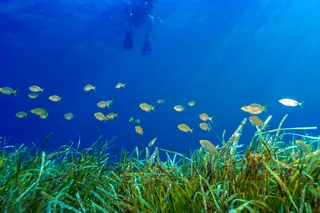
At night, some sleep while others are busy. Fish don't close their eyes when they sleep, as they have no eyelids. A beautiful fauna of nocturnal creatures evolves in the world of night: the hermit crab shares its shell with the sea anemone, the cuttlefish swims elegantly, but in case of danger, it quickly turns back and propels water. Fairy-like creatures light up the night: picarels are often hunted by squid, while the octopus, a tentacled creature with 8 muscular arms, emerges from its secret cave.
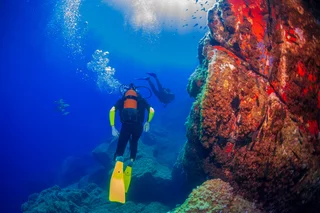
Cartography: a mountain under the sea
You're not dreaming: we're talking about a mountain less than 35 km off the coast, at a depth of 2,300 metres, with a peak at a depth of 1,250 metres. Off the coast of Cap Corse, this never-before-explored relief has scientists in a tizzy. An exploration by the Andromède océanologie team, aboard its trusty catamaran "Le Zembra", will soon take place, providing a highly accurate topography of this underwater mountain. An underwater robot, equipped with sonar and optical cameras, will be tasked with identifying the rich variety of species found on this seamount, including corals, sponges, fish and marine mammals, as well as the Posidonia meadows and coralligenous reefs of the Île de Beauté.
Where to snorkel in Corsica? Where can you see fish?
Grab your mask, snorkel and flippers, and let's go...
At Palombaggia: you'll see lippus mullet, silver fish , octopus and sole hidden in the sand! In the seagrass beds, you'll find saupe, peacock crenilabra and siphonostoma (a small, thin fish that looks like a dead leaf).
On the Lavezzi islands: blennies, girelles, crenilabres, labres merles and perhaps red starfish and the great mother-of-pearl. You'll find peacock wrasse, common wrasse and writing wrasse.
At Cap Corse, in the Negru and Albo marinas, you'll spot a thorny stingray, a denti or brown grouper, red algae, castagnoles, damselfishes, serrans, girelles and sars.
Diving at Capo Rosso, the Scandola Reserve and the Bay of Ajaccio are also ideal spots for snorkeling and scuba diving.
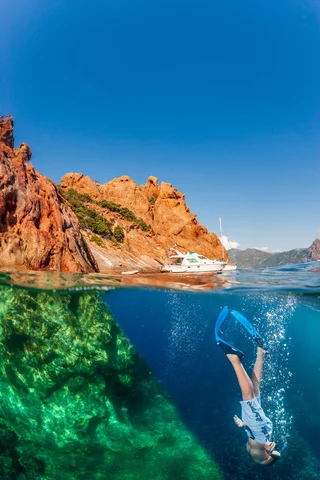
An underwater boat to see the marine fauna
If you're not a fan of snorkeling, you can enjoy the seabed on board a glass-bottomed boat in the Bouches de Bonifacio and its international marine park, or take a semi-submarine tour from Porto and the exceptional visibility of its gulf.
Shipwrecks near the most beautiful beaches
Corsica-du-Sud, with its rugged coastline and rich maritime history, offers many interesting sites for shipwreck exploration. Here are just some of the places where wrecks can be found in Corse-du-Sud:
1. Bonifacio: The waters around Bonifacio are home to several wrecks, including those of Roman ships and warships dating from the Second World War. The region is known for its spectacular dive sites, often offering opportunities for wreck exploration.
2. Gulf of Valinco: This bay between Propriano and Porto Pollo is home to several interesting wrecks, including warships sunk during the Second World War. A number of dive sites in the gulf offer the chance to explore these historic relics.
3. Îles Lavezzi: These islands south of Bonifacio offer crystal-clear waters and are home to several wrecks. Divers can explore these sites while admiring the colorful marine life that thrives around the wrecks.
4. Scandola Nature Reserve: Although located further north, this protected marine reserve also offers opportunities for wreck exploration. The reserve's waters are rich in biodiversity and are home to many historic underwater relics.
Before exploring a wreck, it's important to check local diving regulations and make sure you have the appropriate skills and equipment. What's more, some wrecks may be protected as archaeological sites or because of their ecological importance, so it's essential to respect the marine environment during any exploration.
If we've whetted your appetite for Corsica's underwater world, there are plenty of professionals on hand to help you perfect your skills. Our local advisors will direct you to them and help you plan the trip that 's right for you.
Our local experts answer your questions!
Where to see seahorses in southern Corsica?
Corsica offers several places where you can observe seahorses in their natural habitat. Here are a few places where you might be lucky enough to see them:
- Marine reserves and protected areas: Marine reserves such as Réserve Naturelle de Scandola, Réserve Naturelle des Bouches de Bonifacio, and Réserve Naturelle de Cerbicale are places where marine fauna is abundant and preserved, offering chances to spot seahorses.
- Scuba diving: Diving in sites rich in biodiversity such as the Lavezzi and Cerbicale islands, or around the Scandola reserve, often offers opportunities to spot seahorses.
- Marinas and coastal areas: Seahorses can also be observed in shallow waters near marinas or sheltered coastal areas.
- Marine research and observation centers: Some centers specializing in marine research or biodiversity conservation may offer educational programs or guided tours where you can learn more about seahorses and observe them under controlled conditions.
